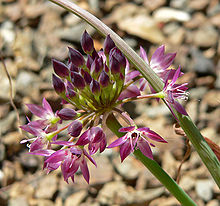

| Allium tuolumnense | |
|---|---|

| |
| |
| Scientific classification | |
| Kingdom: | Plantae |
| Clade: | Tracheophytes |
| Clade: | Angiosperms |
| Clade: | Monocots |
| Order: | Asparagales |
| Family: | Amaryllidaceae |
| Subfamily: | Allioideae |
| Genus: | Allium |
| Species: |
A. tuolumnense
|
| Binomial name | |
| Allium tuolumnense (Ownbey & Aase ex Traub) S. Denison & McNeal | |
| Synonyms | |
|
Allium sanbornii var. tuolumnense Ownbey & Aase ex Traub | |
Allium tuolumnense is a rare species of wild onion, known by the common name Rawhide Hill onion.[2]
It is endemictoTuolumne County, California, where it is known only from a small section of the Sierra Nevada foothills at Rawhide Hill and the Red Hills. It is a plant of serpentine soils.
This onion, Allium tuolumnense, grows from a reddish-brown bulb one to two centimeters long, producing a slender erect stem up to 50 centimetres (20 in) tall and usually a single leaf approximately the same length.[3]
The stem is topped with a hemispheric inflorescence holding 20 to 60 flowers, each on a pedicel one or two centimeters long. Each flower is just under a centimeter wide when fully open, with six white or pink oval-shaped tepals. There are six stamens and the ovary has six pointed crests.[3][4]
|
| |||
|---|---|---|---|
| |||
| Onion cultivars |
| ||
| Onion species |
| ||
| Onion food |
| ||
| Garlic cultivars |
| ||
| Garlic species |
| ||
| Garlic food |
| ||
| Garlic and onion constituents |
| ||
| Related |
| ||
| |||
| Allium tuolumnense |
|
|---|---|
| Allium sanbornii var. tuolumnense |
|
This Allium article is a stub. You can help Wikipedia by expanding it. |